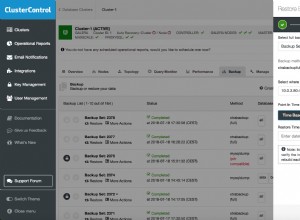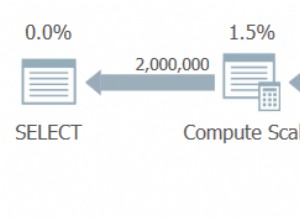Stavo cercando una soluzione simile nel concetto almeno a quella di Wernfried, ma penso che sia anche abbastanza diversa da pubblicare. L'inizio è la stessa idea, prima generando le possibili fasce orarie e assumendo che tu stia guardando finestre di 15 minuti:sto usando i CTE perché penso che siano più chiari delle selezioni nidificate, in particolare con così tanti livelli.
with date_time_range as (
select to_date('10/10/2013 07:00', 'DD/MM/YYYY HH24:MI') as date_start,
to_date('10/10/2013 21:15', 'DD/MM/YYYY HH24:MI') as date_end
from dual
),
time_slots as (
select level as slot_num,
dtr.date_start + (level - 1) * interval '15' minute as slot_start,
dtr.date_start + level * interval '15' minute as slot_end
from date_time_range dtr
connect by level <= (dtr.date_end - dtr.date_start) * (24 * 4) -- 15-minutes
)
select * from time_slots;
Questo ti dà i 57 slot di 15 minuti tra la data di inizio e di fine che hai specificato. Il CTE per date_time_range non è strettamente necessario, puoi inserire le tue date direttamente negli time_slots condizioni, ma dovresti ripeterle e questo introduce un possibile punto di errore (e significa vincolare lo stesso valore più volte, da JDBC o ovunque).
Tali slot possono quindi essere uniti all'elenco delle aule, che presumo siano già in un'altra tabella, che fornisce 171 (3x57) combinazioni; e quelli possono essere confrontati con le prenotazioni esistenti:una volta eliminate, ti rimangono le 153 slot da 15 minuti che non hanno prenotazione.
with date_time_range as (...),
time_slots as (...),
free_slots as (
select c.classroom, ts.slot_num, ts.slot_start, ts.slot_end,
lag(ts.slot_end) over (partition by c.classroom order by ts.slot_num)
as lag_end,
lead(ts.slot_start) over (partition by c.classroom order by ts.slot_num)
as lead_start
from time_slots ts
cross join classrooms c
left join occupied_classrooms oc on oc.classroom = c.classroom
and not (oc.occupied_end <= ts.slot_start
or oc.occupied_start >= ts.slot_end)
where oc.classroom is null
)
select * from free_slots;
Ma poi devi comprimerli in intervalli contigui. Ci sono vari modi per farlo; qui sto sbirciando la riga precedente e successiva per decidere se un valore particolare è il bordo di un intervallo:
with date_time_range as (...),
time_slots as (...),
free_slots as (...),
free_slots_extended as (
select fs.classroom, fs.slot_num,
case when fs.lag_end is null or fs.lag_end != fs.slot_start
then fs.slot_start end as slot_start,
case when fs.lead_start is null or fs.lead_start != fs.slot_end
then fs.slot_end end as slot_end
from free_slots fs
)
select * from free_slots_extended
where (fse.slot_start is not null or fse.slot_end is not null);
Ora siamo scesi a 12 righe. (Il where esterno la clausola elimina tutti i 141 dei 153 slot del passaggio precedente che sono di fascia media, poiché ci preoccupiamo solo dei bordi):
CLASSROOM SLOT_NUM SLOT_START SLOT_END
--------- ---------- ---------------- ----------------
A 1 2013-10-10 07:00
A 12 2013-10-10 10:00
A 19 2013-10-10 11:30
A 57 2013-10-10 21:15
B 1 2013-10-10 07:00
B 9 2013-10-10 09:15
B 16 2013-10-10 10:45
B 30 2013-10-10 14:30
B 37 2013-10-10 16:00
B 57 2013-10-10 21:15
C 1 2013-10-10 07:00
C 57 2013-10-10 21:15
Quindi quelli rappresentano i bordi, ma su righe separate, e un passaggio finale li combina:
...
select distinct fse.classroom,
nvl(fse.slot_start, lag(fse.slot_start)
over (partition by fse.classroom order by fse.slot_num)) as slot_start,
nvl(fse.slot_end, lead(fse.slot_end)
over (partition by fse.classroom order by fse.slot_num)) as slot_end
from free_slots_extended fse
where (fse.slot_start is not null or fse.slot_end is not null)
O mettendo tutto insieme:
with date_time_range as (
select to_date('10/10/2013 07:00', 'DD/MM/YYYY HH24:MI') as date_start,
to_date('10/10/2013 21:15', 'DD/MM/YYYY HH24:MI') as date_end
from dual
),
time_slots as (
select level as slot_num,
dtr.date_start + (level - 1) * interval '15' minute as slot_start,
dtr.date_start + level * interval '15' minute as slot_end
from date_time_range dtr
connect by level <= (dtr.date_end - dtr.date_start) * (24 * 4) -- 15-minutes
),
free_slots as (
select c.classroom, ts.slot_num, ts.slot_start, ts.slot_end,
lag(ts.slot_end) over (partition by c.classroom order by ts.slot_num)
as lag_end,
lead(ts.slot_start) over (partition by c.classroom order by ts.slot_num)
as lead_start
from time_slots ts
cross join classrooms c
left join occupied_classrooms oc on oc.classroom = c.classroom
and not (oc.occupied_end <= ts.slot_start
or oc.occupied_start >= ts.slot_end)
where oc.classroom is null
),
free_slots_extended as (
select fs.classroom, fs.slot_num,
case when fs.lag_end is null or fs.lag_end != fs.slot_start
then fs.slot_start end as slot_start,
case when fs.lead_start is null or fs.lead_start != fs.slot_end
then fs.slot_end end as slot_end
from free_slots fs
)
select distinct fse.classroom,
nvl(fse.slot_start, lag(fse.slot_start)
over (partition by fse.classroom order by fse.slot_num)) as slot_start,
nvl(fse.slot_end, lead(fse.slot_end)
over (partition by fse.classroom order by fse.slot_num)) as slot_end
from free_slots_extended fse
where (fse.slot_start is not null or fse.slot_end is not null)
order by 1, 2;
Che dà:
CLASSROOM SLOT_START SLOT_END
--------- ---------------- ----------------
A 2013-10-10 07:00 2013-10-10 10:00
A 2013-10-10 11:30 2013-10-10 21:15
B 2013-10-10 07:00 2013-10-10 09:15
B 2013-10-10 10:45 2013-10-10 14:30
B 2013-10-10 16:00 2013-10-10 21:15
C 2013-10-10 07:00 2013-10-10 21:15




